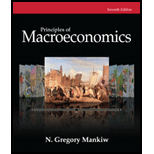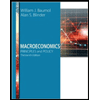
Sub part (a):
The nominal and real GDP and GDP deflator.
Sub part (a):
Explanation of Solution
The GDP is the summation of the monetary value of all the goods and services produced within the political boundary of a country, within a financial year. There are two different ways of calculating the GDP of the economy and they are the real GDP and the nominal GDP. The real GDP is the GDP calculated at the constant prices. There will be a base price index and the value of goods and services will be calculated on the basis of the constant prices. Thus, it will measure the GDP of the economy on the same base year price index, which will help us to identify the inflation in the economy. The nominal GDP is the GDP calculated at the current prices. The GDP will be calculated by multiplying the quantity of goods and services produced with the current year’s market prices which will include the inflation impact.
The nominal GDP of the economy can be calculated by multiplying the quantity produced by the per unit price of the commodity. The quantity produced and price in 2016 was 100 quarts of milk and 50 quarts of honey. The prices were $1 and $2 respectively, for each quart. Thus, the nominal GDP of 2016 can be calculated as follows:
Thus, the nominal GDP of 2016 is $200.
Similarly, the quantity produced and price in 2017 was 200 quarts of milk and 100 quarts of honey. The prices were $1 and $2, respectively. Thus, the nominal GDP of 2017 can be calculated as follows:
Thus, the nominal GDP of 2017 is $400.
Similarly, the quantity produced in 2018 was 200 quarts of milk and 100 quarts of honey but the prices increased to $2 and $4, respectively. Thus, the nominal GDP of 2018 can be calculated as follows:
Thus, the nominal GDP of 2018 is $800.
The real GDP can be calculated by multiplying the quantity produced with the base year price level. Since the base year is 2016, the nominal GDP of 2016 will be equal to the real GDP of 2016, which is equal to $200.
In the case of 2017, the real GDP can be calculated by multiplying the 2017 quantity with the 2016 price as follows:
Thus, the real GDP of 2017 is $400.
In the case of 2018, the real GDP can be calculated by multiplying the 2018 quantity with the 2016 price. Since there is no change in the quantity produced in 2018 and 2017 in the two commodities of milk and honey, there will be no change in the real GDP of the two years and thus, the real GDP of 2018 will be the same as 2017, which is $400.
The GDP deflator is the implicit price deflator. It can be calculated by dividing the nominal GDP with the real GDP and multiplying the value with 100 as follows:
Thus, by substituting the values of nominal and real GDP in the equation, we can calculate the GDP deflator as follows:
Thus, the GDP deflator in 2016 is 100. Similarly, the GDP deflator for 2017 can be calculated as follows:
Thus, the GDP deflator in 2017 is also 100.
The GDP deflator for 2018 can be calculated as follows:
Thus, the GDP deflator in 2018 is 200.
These values can be tabulated as follows:
Table 1
| Year | Nominal GDP | Real GDP | GDP Deflator |
| 2016 | $200 | $200 | 100 |
| 2017 | $400 | $400 | 100 |
| 2018 | $800 | $400 | 200 |
Concept introduction:
Gross Domestic Product (GDP): It is the summation of the monetary value of all the goods and services produced within the political boundary of a country, within a financial year.
GDP deflator: It is an implicit price deflator.
Sub part (b):
The Percentage change in nominal and real GDP and GDP deflator.
Sub part (b):
Explanation of Solution
The percentage change in nominal GDP can be calculated by the following formula:
Thus, by substituting the values for the current year and previous year, we can calculate the percentage change in the nominal GDP as follows:
Thus, the percentage change in nominal GDP of 2017 is 100 percent.
Thus, the percentage change in nominal GDP of 2018 is also 100 percent.
Similarly, the percentage change in real GDP and GDP deflator can be calculated as follows:
The percentage change in real GDP of 2017 is 100 percent.
The percentage change in real GDP of 2018 is 0 percent.
The percentage change in the GDP deflator can be calculated as follows:
Thus, the percentage change in GDP deflator of 2017 is 0 percent.
Thus, the percentage change in GDP deflator of 2018 is 100 percent.
The prices in the economy remain the same in the year 2016 and 2017, which leads to no change in the percentage change in the GDP deflator. This is why the GDP deflator percentage change is zero. Similarly, the output levels remain the same in the years 2017 and 2018, which leads to the value of percentage change in the real GDP to remain at zero.
Concept introduction:
Gross Domestic Product (GDP): It is the summation of the monetary value of all the goods and services produced within the political boundary of a country, within a financial year.
GDP deflator: It is an implicit price deflator.
Sub part (c):
Economic well-being.
Sub part (c):
Explanation of Solution
The economic well-being increased much larger in the year of 2017, when compared to 2016 and 2018. This result is obtained from the analysis of the data that the real GDP remained the same in 2018 as the real GDP in the 2017. Thus, there were no changes in the real GDP after 2017. But after 2016, the real GDP increased from $200 to $400 in 2017. This means that the well-being rose more in 2017. Another reason why the well-being didn’t rise in 2018 was the price hike. The output remained the same, whereas prices doubled.
Concept introduction:
Gross Domestic Product (GDP): It is the summation of the monetary value of all the goods and services produced within the political boundary of a country, within a financial year.
Want to see more full solutions like this?
Chapter 10 Solutions
Principles of Macroeconomics (MindTap Course List)
- Test Preparation QUESTION 2 [20] 2.1 Body Mass Index (BMI) is a summary measure of relative health. It is calculated by dividing an individual's weight (in kilograms) by the square of their height (in meters). A small sample was drawn from the population of UWC students to determine the effect of exercise on BMI score. Given the following table, find the constant and slope parameters of the sample regression function of BMI = f(Weekly exercise hours). Interpret the two estimated parameter values. X (Weekly exercise hours) Y (Body-Mass index) QUESTION 3 2 4 6 8 10 12 41 38 33 27 23 19 Derek investigates the relationship between the days (per year) absent from work (ABSENT) and the number of years taken for the worker to be promoted (PROMOTION). He interviewed a sample of 22 employees in Cape Town to obtain information on ABSENT (X) and PROMOTION (Y), and derived the following: ΣΧ ΣΥ 341 ΣΧΥ 176 ΣΧ 1187 1012 3.1 By using the OLS method, prove that the constant and slope parameters of the…arrow_forwardQUESTION 2 2.1 [30] Mariana, a researcher at the World Health Organisation (WHO), collects information on weekly study hours (HOURS) and blood pressure level when writing a test (BLOOD) from a sample of university students across the country, before running the regression BLOOD = f(STUDY). She collects data from 5 students as listed below: X (STUDY) 2 Y (BLOOD) 4 6 8 10 141 138 133 127 123 2.1.1 By using the OLS method and the information above derive the values for parameters B1 and B2. 2.1.2 Derive the RSS (sum of squares for the residuals). 2.1.3 Hence, calculate ô 2.2 2.3 (6) (3) Further, she replicates her study and collects data from 122 students from a rival university. She derives the residuals followed by computing skewness (S) equals -1.25 and kurtosis (K) equals 8.25 for the rival university data. Conduct the Jacque-Bera test of normality at a = 0.05. (5) Upon tasked with deriving estimates of ẞ1, B2, 82 and the standard errors (SE) of ẞ1 and B₂ for the replicated data.…arrow_forwardIf you were put in charge of ensuring that the mining industry in canada becomes more sustainable over the course of the next decade (2025-2035), how would you approach this? Come up with (at least) one resolution for each of the 4 major types of conflict: social, environmental, economic, and politicalarrow_forward
- How is the mining industry related to other Canadian labour industries? Choose one other industry, (I chose Forestry)and describe how it is related to the mining industry. How do the two industries work together? Do they ever conflict, or do they work well together?arrow_forwardWhat is the primary, secondary, tertiary, and quaternary levels of mining in Canada For each level, describe what types of careers are the most common, and describe what stage your industry’s main resource is in during that stagearrow_forwardHow does the mining industry in canada contribute to the Canadian economy? Describe why your industry is so important to the Canadian economy What would happen if your industry disappeared, or suffered significant layoffs?arrow_forward
- What is already being done to make mining in canada more sustainable? What efforts are being made in order to make mining more sustainable?arrow_forwardWhat are the environmental challenges the canadian mining industry face? Discuss current challenges that mining faces with regard to the environmentarrow_forwardWhat sustainability efforts have been put forth in the mining industry in canada Are your industry’s resources renewable or non-renewable? How do you know? Describe your industry’s reclamation processarrow_forward
- How does oligopolies practice non-price competition in South Africa?arrow_forwardWhat are the advantages and disadvantages of oligopolies on the consumers, businesses and the economy as a whole?arrow_forward1. After the reopening of borders with mainland China following the COVID-19 lockdown, residents living near the border now have the option to shop for food on either side. In Hong Kong, the cost of food is at its listed price, while across the border in mainland China, the price is only half that of Hong Kong's. A recent report indicates a decline in food sales in Hong Kong post-reopening. ** Diagrams need not be to scale; Focus on accurately representing the relevant concepts and relationships rather than the exact proportions. (a) Using a diagram, explain why Hong Kong's food sales might have dropped after the border reopening. Assume that consumers are indifferent between purchasing food in Hong Kong or mainland China, and therefore, their indifference curves have a slope of one like below. Additionally, consider that there are no transport costs and the daily food budget for consumers is identical whether they shop in Hong Kong or mainland China. I 3. 14 (b) In response to the…arrow_forward
 Economics (MindTap Course List)EconomicsISBN:9781337617383Author:Roger A. ArnoldPublisher:Cengage Learning
Economics (MindTap Course List)EconomicsISBN:9781337617383Author:Roger A. ArnoldPublisher:Cengage Learning
 Macroeconomics: Principles and Policy (MindTap Co...EconomicsISBN:9781305280601Author:William J. Baumol, Alan S. BlinderPublisher:Cengage Learning
Macroeconomics: Principles and Policy (MindTap Co...EconomicsISBN:9781305280601Author:William J. Baumol, Alan S. BlinderPublisher:Cengage Learning Principles of Economics, 7th Edition (MindTap Cou...EconomicsISBN:9781285165875Author:N. Gregory MankiwPublisher:Cengage Learning
Principles of Economics, 7th Edition (MindTap Cou...EconomicsISBN:9781285165875Author:N. Gregory MankiwPublisher:Cengage Learning Essentials of Economics (MindTap Course List)EconomicsISBN:9781337091992Author:N. Gregory MankiwPublisher:Cengage Learning
Essentials of Economics (MindTap Course List)EconomicsISBN:9781337091992Author:N. Gregory MankiwPublisher:Cengage Learning Principles of Economics (MindTap Course List)EconomicsISBN:9781305585126Author:N. Gregory MankiwPublisher:Cengage Learning
Principles of Economics (MindTap Course List)EconomicsISBN:9781305585126Author:N. Gregory MankiwPublisher:Cengage Learning





